Optimizing Sleep Architecture for Better Health and Performance
 by Lilian Nienow
by Lilian Nienow
Discover how analyzing sleep architecture can transform your health optimization efforts. By using wearable technology, individuals can gain insights into sleep stages and make targeted improvements for enhanced cognitive function and overall well-being, all within biohacking practices.

Sleep architecture refers to the structure and pattern of sleep cycles that occur throughout the night. This includes various stages like light sleep, deep sleep, and REM sleep, each playing a vital role in recovery and mental clarity. For those interested in biohacking, examining sleep architecture offers a pathway to fine-tune daily routines.
One key aspect is how sleep stages influence physical restoration. Deep sleep, for instance, supports muscle repair and immune function, making it essential for athletes and busy professionals. By focusing on wearable technology, such as smart rings or fitness bands, users can track these patterns with ease. These devices provide data on sleep duration and quality, helping identify disruptions that affect energy levels.
In biohacking circles, improving sleep architecture often involves simple adjustments. For example, maintaining a consistent bedtime routine can stabilize sleep cycles. This practice not only aids in faster sleep onset but also enhances the overall efficiency of rest periods. Nootropics, like certain natural supplements, may complement this by promoting relaxation without sedation, though their use should align with personal health goals.
Why Focus on Sleep Analysis?
The benefits of sleep architecture analysis extend to cognitive enhancement. REM sleep, associated with dreaming, plays a part in memory consolidation and emotional processing. Poor REM sleep might lead to foggy thinking or reduced focus, which can hinder productivity. Through regular monitoring, individuals can detect imbalances and apply changes, such as optimizing room temperature or reducing blue light exposure before bed.
Wearable devices have become a cornerstone in this process. They offer detailed reports on sleep metrics, allowing for data-driven decisions. For instance, if analysis reveals insufficient deep sleep, one might experiment with dietary tweaks or light exercise routines. This approach empowers users to take control of their health, turning insights into actionable steps for personal enhancement.
Practical Steps for Improvement
To begin analyzing your own sleep, start by selecting a reliable wearable tracker. These tools often include apps that visualize data, making it straightforward to spot trends. Once you have baseline information, consider environmental factors. A cooler room and comfortable bedding can significantly impact sleep quality, leading to more restorative nights.
Incorporating elements of biohacking can further refine this. Some explore natural aids to support sleep stages, ensuring they complement rather than replace core habits. Over time, consistent analysis can reveal patterns tied to lifestyle choices, such as caffeine intake or screen time, guiding more informed decisions.
The role of sleep in personal enhancement cannot be overstated. Better architecture means improved mood, sharper cognition, and greater resilience to stress. By prioritizing this, tech-savvy enthusiasts can achieve sustained performance gains. Remember, small, consistent changes often yield the most profound results.
Integrating with Daily Life
For wellness seekers, combining sleep analysis with other biohacking strategies creates a holistic approach. Tracking progress over weeks can show how enhancements in sleep lead to better workout recovery or increased mental stamina. This integration fosters a cycle of continuous improvement, where each night's rest builds upon the last.
Ultimately, dedicating effort to sleep architecture analysis paves the way for a more optimized life. It's about harnessing available tools and knowledge to unlock your potential, step by step. With patience and persistence, the rewards in health and vitality become clear, motivating further exploration in this fascinating area.
